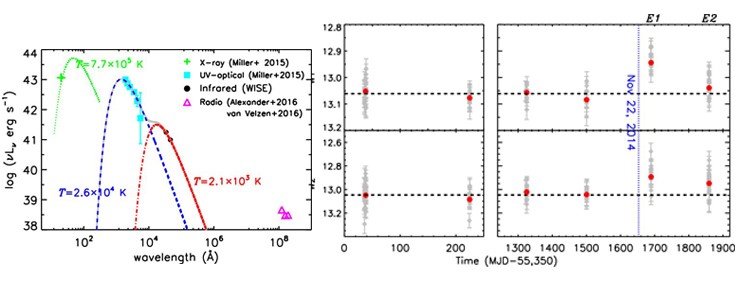For the first time, the group in the Department of Astronomy in the University of Science and Technology of China (USTC) detected a significant infrared echo of stars being destroyed by supermassive black holes, using public infrared observations from the Wide-field Infrared Survey Explorer (WISE) telescope. This can give crucial information about the size of the black hole and the processes it is driving at the center of a galaxy.
Astronomers have proved that most massive galaxies contain supermassive black holes in the center orbited by billions of stars. Those center black holes can be hungry monsters that could pull apart nearby starts by its gravitational glue. While the star is getting too closed to the black hole, the strong gravity field will be disrupted the star and swallow the materials finally by forming an accretion disk. This "Tidal Disruption Event" or TDE provides unique laboratory to study the accretion physics of supermassive black holes. However, only dozens TDEs have been detected for the observational limitation in the last decades. No fared flares from these TDEs have been detected, even though astronomers believe the surrounding dust will be illuminated by the supermassive black holes.

Figure. 1 This illustration shows a glowing stream of material from a star as it is being devoured by a supermassive black hole in a tidal disruption flare. (Copyright by NASA /JPL-Caltech)
WANG Tinggui, and his student JIANG Ning, carefully checked every infrared observation of TDEs from public database of WISE telescope. An unprecedented significant infrared flare is detected associated with the nearest TDE called ASASSN- 14li. Ning said, "We was surprised while detecting such notable signal and this is the first time. I finished the draft in only one week."
The flare allows them to measure the emitted energy much more precisely than ever before. Such study also opens a new window to observe the galaxy center.

Figure. 2 The spectral energy distribution and the detected infrared flares for the TDE named ASASSN-14li.
Inspired by the success, another team member DOU Liming leaded another study with the same public observations. They detect infrared flare signal from another four TDEs (https://arxiv.org/abs/1605.05145). More candidates and follow up observations will be reported later. Another astronomer, Dr Sjoert van Velze, at Johns Hopkins University in Baltimore also reported similar finding at nearly the same time in the separate study, but they only detected weaker signals. These studies help astronomers make new estimates of the dust that encircles supermassive black holes at the center of distant galaxies.
This work was published in Astrophysical Journal Letters entitled "The WISE Detection of an Infrared Echo in Tidal Disruption Event Asassn-14li".It is supported by National Basic Research Program of China, the Strategic Priority Research Program “The Emergence of Cosmological Structures” of the Chinese Academy of Sciences, the Fundamental Research Funds for the Central Universities, and CAS “Light of West China” Program.
The link of the paper: http://iopscience.iop.org/article/10.3847/2041-8205/828/1/L14
CONTACT:
JIANG Ning
Key Laboratory for Research in Galaxies and Cosmology, Department of Astronomy,
The University of Science and Technology of China,
Hefei, Anhui 230026, China.
jnac@ustcnet.